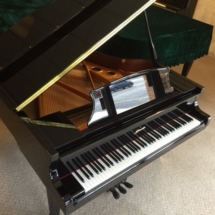
Steinway & Sons chose the world’s largest maker of pianos (Pearl River) to build their Essex line. Read on to learn about a piano that rivals the best of what America and Europe has to offer at a price that will defy logic.
A pre owned Yamaha or Kawai baby grand piano for $7,500-$12,000 often times is the quick easy solution when one is searching for a piano. Both brands enjoy a reasonably good reputation, and so far as mass produced pianos go, both construct adequate, consistent instruments.
However, the industry in the last 10 years has evolved quite a bit. Yamaha and Kawai have been and continue to be more focused on their digital and player piano lines and have done nothing to perfect the art of piano making. In fact, I would argue that it has gone backwards. Readers need to understand that 80+% of what Yamaha and Kawai sell today are not built in Japan. Globalization has shifted production to countries such as China and Indonesia, where labor rates are favorable.
Leaving Japan and going to China is not at the heart of the problem. Kawai, Yamaha, or any other piano manufacturer is fully capable of producing a quality piano anywhere in the world. The issue is for some peculiar reason Yamaha and Kawai strip out all of the refinements they are known for, from their Chinese, Indonesian and Taiwanese made pianos. Why this is done is not clearly understood. One piano craftsman in Japan cost $75,000 per year. In China it is less than 20% of this amount. This means there is a significant amount of monies left over to refine the piano. It is widely believed Yamaha and Kawai do not produce a Japanese caliber piano in China, because if they did, not a single tremendously more expensive Japanese made piano would ever sell again.
With the Japanese resting on their laurels and the Internet age coming alive; the European hybrid formula was born. The definition of a European hybrid piano is the fusion of European componentry assembled where labor rates are favorable. In these pianos the absolute best materials are used. Every tangible component that can be measured or observed, in each step of the building process is incrementally or substantially better in a piano such as a Ritmüller, than that of a similarly priced Yamaha or Kawai.
Ritmüller pianos date back to the late 18th century. Recently they were completely redesigned by Lothar Thomma, with the goal being to fuse the best components the world has to offer, chiefly from Europe, with the most accurate forms of modern construction, such as the use of more precise CNC machinery.
The importance of Lothar Thomma’s involvement can not be overstated. For decades Lothar sat at the helm of the engineering department at the world’s highest rated piano maker, Bechstein; a handmade piano built exclusively in Germany. Thomma was hired by the world’s largest piano manufacturer, a brand which also is the official builder for Steinway’s Essex line of pianos, to breathe new life into an old standard. Thomma has achieved world wide success and notoriety with his new Ritmüller designs.
This is illustrated perfectly in the Piano Book by Larry Fine and is likely the single most powerful point that can be made with regard to the quality of a Ritmuller piano. You will notice in the following chart that there are three areas of concern.
Classical Perennial Favorites – This is essentially what is popular.
Musical Standouts – Amongst connoisseurs and aficionados what is considered musically sublime.
Good Value – Best bang per buck
Most people respond that musical standout status of these three categories is the most important and this is precisely what I would like to bring your attention to. But before I point this out, it is important to know that size matters in pianos. The longer a grand piano is the larger the soundboard is, which is the speaker in the piano and the longer the strings become. String length and soundboard size determine decibel production or overall volume. Therefore, smaller pianos are more difficult to make musical. While larger pianos are easier to make musical.
Scroll down and look at grands between 4’10 – 5’4. Is Yamaha, Kawai or even Steinway present as a musical standout They are not! Ritmüller is! Fine writes, Amazingly good performance from such a small piano. He also naturally checks the boxed under good value for this piano.
Yamaha, Kawai and Steinway only achieve musical standout status in the upper 6′-7′ range!
If one wants a musical standout from Yamaha one would have to spend $57,000 for a 6’7 semi concert grand.
A Kawai would set you back $78,000 in a handmade Shigeru 7′ concert grand.
Both of which are less than the $100,000+ that one would have to outlay for a Steinway model B (7′).
Ritmuller somehow finds a way to make a inherently non musical size piano a musical standout.
A NEW Ritmüller 4’11 baby grand in ebony polish lists for $17,500. Dave’s Piano Showroom is offering it for only $12,900!
The sale includes
Delivery
Tuning
Prep work
One tuning
10 year Ritmüller warranty
Matching bench







